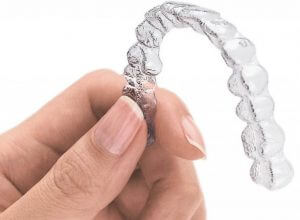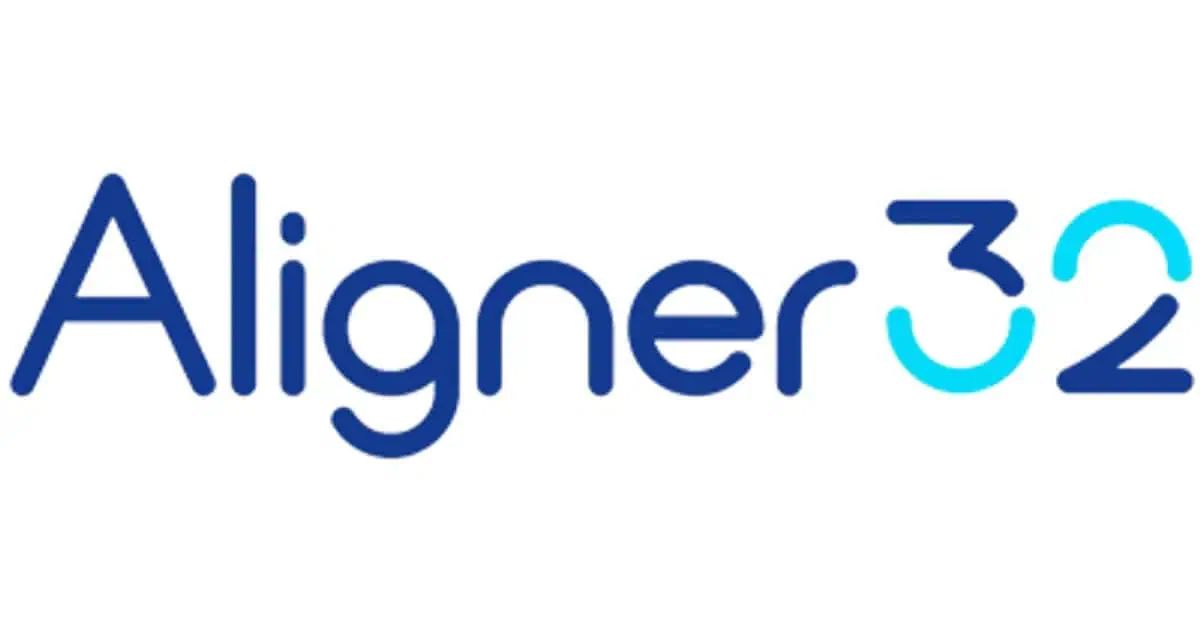If you’re trying to choose between Invisalign or braces, there’s a lot to consider. Cost, speed of treatment, appearance, and comfort will all play a part in your decision between clear aligners and traditional fixed braces.
You might be considering clear ceramic braces or lingual braces too, as an alternative to traditional metal.
We understand that this is an important choice. After all, once you have begun your orthodontics treatment, you can’t easily switch to another type of adult braces.
So here, we’re going to look at all the different aspects of Invisalign vs braces, including:
- What Invisalign and braces cost
- Which is faster
- Which is better: Invisalign or braces
- The practicalities of wearing clear aligners and fixed braces
- How to decide which is best for you
Let’s get started!
In This Article
Traditional braces vs Invisalign: Similarities and differences
Whether you want to straighten crooked teeth, close a gap in your teeth, or reduce crowding, the overall goal of braces and Invisalign clear aligners is the same: to bring your teeth into better alignment.
Straighter teeth not only help you feel more confident but are also easier to care for long-term. In more severe cases, orthodontic work can also improve speech and reduce problems like teeth grinding.
All orthodontic treatment works by applying pressure to teeth to gradually move them. But this is really where the similarities between Invisalign and regular braces end.

Traditional braces involve having brackets cemented to each tooth with a wire joining them. Invisalign, on the other hand, involves a series of removable clear plastic aligners that fit snugly over the teeth.
Aligners are very difficult to spot, which is why they are also known as ‘invisible braces’. The fact that they can be removed means it’s easier to clean your teeth during your treatment.
However, some people find it inconvenient having to wear them for 20-22 hours per day. You’re not allowed to eat or drink anything except water while wearing aligners.
Finally, it’s important to note that not everybody is a good candidate for Invisalign. Although they can treat around 90% of cases, the most severe malocclusion will require fixed braces (and perhaps surgery).
Here’s a table summarizing some of the key differences between Invisalign and braces:
Traditional braces | Invisalign | |
Appearance | Metal brackets and wires are very noticeable | Clear plastic aligners are almost invisible |
Eating restrictions | Some foods not allowed | No restrictions when aligners are removed; no eating with aligners in |
Cleaning | A bit difficult to clean; require special care | Clean teeth as normal when aligners are removed |
Maintenance | Usually just regular checkups and adjustments | Aligners can be lost or damaged |
Cost | $2,500–$7,500 | $3,500–$8,500 |
Eligibility | Suitable for all cases | Suitable for 90% of cases |
Clear ceramic braces vs Invisalign
Ceramic braces use a clear or tooth-colored material so the brackets and wire are far less noticeable. However, they are still fixed to the front of your teeth and are generally less comfortable and more obvious than Invisalign.
Still, if you’re concerned about aesthetics and Invisalign is not an option for you, clear braces are a good alternative to metal. The cost of clear braces and Invisalign is usually about the same.
Damon braces vs Invisalign
Damon braces are a brand of self-ligating braces. These braces use a sliding mechanism that gradually moves the teeth without the need for rubber bands like with traditional braces.
The result actually means that these braces, even though they require the use of brackets, have a lot in common with Invisalign — treatment time is faster, clear brackets are virtually invisible, and there are fewer office visits and less pressure on the teeth.
The main differences between Damon braces and Invisalign are that:
- Damon braces can treat more severe cases than Invisalign
- Damon braces use brackets and Invisalign uses plastic trays
- Invisalign is more discreet than Damon
- Treatment time with Invisalign is shorter
- The result with Damon is more pronounced
Find out more about elastic-free straightening in our Damon braces article.
Lingual braces vs Invisalign
Lingual braces use metal brackets but they are fixed behind your teeth. This makes them, in a way, even less noticeable than Invisalign. Some people find that lingual braces affect their speech or cause tongue sores at first, but this is usually only a temporary problem. Additionally, metal allergy reactions must be considered when opting for these braces.
It’s often the case that lingual braces cost more than Invisalign, especially if you choose a brand with custom-fitted brackets.
Find out more in our article about Invisalign vs lingual braces.
Invisalign vs braces: Cost
Price is a big factor when deciding which braces are right for you, so what about the cost of Invisalign vs regular braces in the US?
The first thing to know is that the cost of any orthodontic work will depend on the complexity and duration of your treatment.

Some people need minor tooth movement, which can be achieved in under six months. Others need significant correction that requires 18 months or more.
And it stands to reason that the longer your treatment is, the more time you’ll spend in your dentist’s office and the more materials will be required. This all pushes up the cost.
Putting treatment length aside, we can say that in general, treatment with metal braces is usually available for slightly less than the price of Invisalign. However, many patients are willing to pay a little extra in return for the convenience and discreetness of Invisalign.
Please do keep in mind that individual quotes will vary — you can call 866-383-0748 to find an Invisalign dentist near you who can give you a detailed price quote.
Invisalign vs braces: Which is faster?

Another common question is whether Invisalign or braces are faster. It’s understandable that you want to get your teeth straightened as fast as possible, and in this case, you may want to opt for Invisalign.
This study found that clear aligners do result in faster treatment times as well as less time in the dentist’s chair. This can be especially true for less complex cases provided there is proper compliance following treatment. However, once the treatment plan has begun, if modifications are required after the initial plan, it might take additional time. The good news is that Invisalign allows examination in detail prior to treatment.
Are braces better than Invisalign?
When it comes to Invisalign vs braces effectiveness, most patients can be treated just as effectively with Invisalign as with metal braces. However, in around 10% of cases, fixed braces will be a better option. Invisalign is best suitable for simple to moderate non-extraction alignments, which represent around 90% of cases.
This report states that, “Although it is possible to treat complex malocclusion with plastic systems, the results are less accurate than those achieved with fixed appliances.” So, if you have a more complex case, it may be that fixed braces will give a better result.
In the video below, Dr. Greg Asatrian gives an in-depth review of the differences between all of the different types of braces and Invisalign.
In his opinion, as long as your case of malocclusion can be treated by both braces and Invisalign, the results won’t be very different. Both braces and Invisalign are effective ways to straighten teeth.
Straightening teeth without braces or Invisalign
If you don’t want traditional braces, but the price of Invisalign is out of reach, there is another option you may want to consider — clear aligners.
Clear aligners offer an affordable, discreet, and convenient way to straighten your teeth. These aligners tend to be much cheaper than either traditional braces or Invisalign, and the treatment time for most brands averages just 6 months.
Have a look at some of our top picks for clear aligners to see if this could be a good option for you.
- Most affordable options
- Single and dual arch, day and night options
- Convenient AlignerTracker app
- Free teeth whitening
Aligner32 offers a convenient and affordable way for individuals to straighten their teeth using custom-fit clear aligners. Their service is designed for at-home use, allowing customers to avoid frequent orthodontist visits while still achieving professional-grade results.
Aligner32 provides two main treatment plans tailored to suit different needs:
- All-Day Plan: The All-Day Plan requires 22 hours of daily wear and offers faster results, with treatment lasting between 4 to 6 months.
- Night Wear Plan: The Night Wear Plan is ideal for those who prefer a more flexible routine, requiring just 10 hours of daily wear, typically at night, with a treatment duration of 6 to 8 months.
Both plans are designed to treat a range of orthodontic issues, including crowding, spacing, overbites, underbites, and crossbites.
With affordability in mind, Aligner32’s clear aligners are significantly less expensive than traditional braces, which can cost between $5,000 to $8,000. Customers can also use flexible payment plans, making it easier to manage the cost.
Additionally, Aligner32 offers a free teeth whitening kit with their aligner packages, making the treatment even more appealing. The company emphasizes comfort, convenience, and professional care, making it a popular choice for those seeking a better smile without the high costs and hassle of conventional orthodontic treatments.
- Complete treatment 100% remotely
- Amazing customer service
- Nighttime-only option
- $1,495 or $55/month
NewSmile aligners are made from the clearest Essix plastic and come with a daytime or nighttime-only option to suit you. For just $1,495 you’ll receive everything you need to straighten and whiten your teeth – and maintain your new smile:
- Home impression kit
- Full aligner treatment
- Free whitening
- First set of retainers
- A full refund if you’re not a good fit
NewSmile goes above and beyond to provide a great experience to all their customers, beginning with a live video call to help you with your teeth impressions. Mail these back, and they’ll send a 3D Treatment Preview for you to approve before going ahead.
- Smileie Pro offers hybrid treatment!
- Single-arch treatment option
- Nighttime aligners available
- Free refinements & 2 sets of retainers
- $699 (single-arch) or $999 (dual-arch)
Smileie’s aligner treatment is not only affordable, but flexible too. You have the option of Smileie Pro, which is hybrid treatment that involves in-office visits with a dentist.
That means more accurate, safer and effective treatment or a wider variety of cases.
But you can also opt for single-arch treatment for just your top or bottom teeth, as well as nighttime-only treatment. And whichever package you choose, monthly payments are available.
On top of this, Smileie offers a 100% satisfaction guarantee which includes free refinements if needed. Their aligners are made in the US and treatment takes 4-6 months on average.
Get Smileie Pro for just $1499, or —
Get the best discount on the standard plan, with 100% remote treatment, when you purchase your aligner package up-front, including:
- Home impression kit
- Teeth whitening kit
- Two sets of retainers
- A full refund if you’re not a good candidate
Packages start at $699 for single-arch treatment. Click below to check for current discounts!
- Complete treatment 100% remotely
- 4-6 month average treatment time
- Nighttime-only option
- $770 or $64/month
If you’re looking for the best value aligner package, here it is! For just $895 you’ll get:
- Impression kit
- Full aligner treatment course
- Free teeth whitening kit
- Your first set of retainers
In short, everything needed to straighten your teeth remotely and keep them looking great, with a full money-back guarantee if you’re not a suitable candidate.
This low price doesn’t mean you’re compromising on quality of care, though. ALIGNERCO just choose not to put so much into marketing, and they pass on the savings to their customers. They are also known for their responsive and helpful customer care, which is important when you’re doing things from home.
Nighttime-only aligners are also available for anyone who doesn’t want to wear aligners during the day.
You can read more about alternatives to Invisalign here, or find out more about the best invisible braces in our full article here. We also have an Invisalign cost calculator so you can get a cost estimate.
Conclusion
Having looked at Invisalign vs braces in detail, we can say that Invisalign might be a better choice if you:
- Want the least noticeable option
- Need mild or moderate tooth movement
- Would prefer to be able to eat what you like and clean your teeth as normal
- Have the willpower to wear your aligners as directed
- Are allergic to metal
On the other hand, fixed braces may be better for you if you:
- Would like to be able to eat whenever you want
- Need complex tooth movement
- Are looking for the cheapest treatment option
FAQs
Are braces or Invisalign cheaper?
This depends on the duration and complexity of your tooth movement. Metal braces are generally the cheapest option, but Invisalign prices are often comparable. The best way to know for sure is to book a consultation.
Are braces faster than Invisalign?
No, not necessarily. In fact, in many cases, Invisalign is faster than braces. Invisalign treatment can be as short as 3 months, and the average duration is 6-12 months. This will vary depending on case severity.
Is Invisalign more comfortable than braces?
It’s well known that fixed brace brackets can irritate the gums and cause mouth sores. Clear aligners have a smooth surface that eliminates this problem, making them more comfortable to wear.
Occasionally, patients experience discomfort from one of the edges of their aligners. If this occurs, you can mention it to your dentist or simply use a nail file to smooth the part in question.
BMC Oral Health: A comparison of treatment effectiveness between clear aligner and fixed appliance therapies. Consulted 3rd July 2021.
The Korean Journal of Orthodontics: A systematic review of the accuracy and efficiency of dental movements with Invisalign®. Consulted 3rd July 2021.







